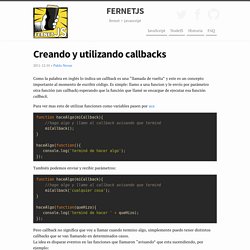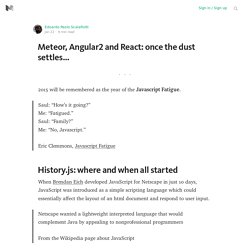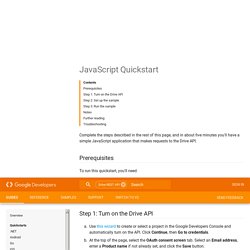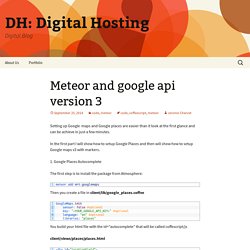

Function Call Back Eloquent. jQuery Callback Function. Creando y utilizando callbacks. Como la palabra en inglés lo indica un callback es una “llamada de vuelta” y este es un concepto importante al momento de escribir código.

Es simple: llamo a una funcion y le envío por parámetro otra función (un callback) esperando que la función que llamé se encargue de ejecutar esa función callback. Para ver mas esto de utilizar funciones como variables pasen por aca function haceAlgo(miCallback){ //hago algo y llamo al callback avisando que terminé miCallback();} haceAlgo(function(){ console.log('terminó de hacer algo');}); También podemos enviar y recibir parámetros: function haceAlgo(miCallback){ //hago algo y llamo al callback avisando que terminé miCallback('cualquier cosa');} haceAlgo(function(queHizo){ console.log('terminó de hacer ' + queHizo);}); Pero callback no significa que voy a llamar cuando termino algo, simplemente puedo tener distintos callbacks que se van llamando en determinados casos. También lo podemos utilizar declarando funciones nombradas y separando la lógica:
Meteor, Angular2 and React: once the dust settles… 2015 will be remembered as the year of the Javascript Fatigue.

Saul: “How’s it going?” Me: “Fatigued.”Saul: “Family?” Me: “No, Javascript.” Eric Clemmons, Javascript Fatigue History.js: where and when all started When Brendan Eich developed JavaScript for Netscape in just 10 days, JavaScript was introduced as a simple scripting language which could essentially affect the layout of an html document and respond to user input. Netscape wanted a lightweight interpreted language that would complement Java by appealing to nonprofessional programmers From the Wikipedia page about JavaScript … and some of the weird quirks of the language continues to stick today like the absence of real inheritance (instead, see “object delegation”), weird bugs like typeof null === “object” // true, the choice of going full IEEE 754 0.1 + 0.2 === 0.3 // false etc… Hello, Node!
There is also another thing to keep in mind: JavaScript is not strictly a “project” nor a “programming language”. Back to the point. Tutorial FIREBASE. JSON with Ajax. AJAX is Asynchronous JavaScript and XML, which is used on the client side as a group of interrelated web development techniques, in order to create asynchronous web applications.

According to the AJAX model, web applications can send and retrieve data from a server asynchronously without interfering with the display and the behavior of the existing page. Many developers use JSON to pass AJAX updates between the client and the server. Websites updating live sports scores can be considered as an example of AJAX.
If these scores have to be updated on the website, then they must be stored on the server so that the webpage can retrieve the score when it is required. This is where we can make use of JSON formatted data. Any data that is updated using AJAX can be stored using the JSON format on the web server. The following code shows JSON with AJAX. Given below is the input file data.json, having data in JSON format which will be uploaded asynchronously when we click the Update Detail button. Function Call Back Eloquent. Learn.knockoutjs.com. JavaScript Quickstart Var SCOPES = [' /** * Handle response from authorization server. * * @param {Object} authResult Authorization result. */ function handleAuthResult(authResult) { var authorizeDiv = document.getElementById('authorize-div'); if (authResult && !

AuthResult.error) { // Hide auth UI, then load client library. authorizeDiv.style.display = 'none'; loadDriveApi(); } else { // Show auth UI, allowing the user to initiate authorization by // clicking authorize button. authorizeDiv.style.display = 'inline'; } } /** * Load Drive API client library. */ function loadDriveApi() { gapi.client.load('drive', 'v3', listFiles); } /** * Append a pre element to the body containing the given message * as its text node. * * @param {string} message Text to be placed in pre element. */ function appendPre(message) { var pre = document.getElementById('output'); var textContent = document.createTextNode(message + '\n'); pre.appendChild(textContent); }
Meteor and google api version 3. Setting up Google maps and Google places are easier than it look at the first glance and can be achieve in just a few minutes.

In the first part I will show how to setup Google Places and then will show how to setup Google maps v3 with markers. 1. Google Places Autocomplete The first step is to install the package from Atmosphere: meteor add mrt:googlemaps Then you create a file in client/lib/google_places.coffee GoogleMaps.init sensor: false #optional key: "<YOUR_GOOGLE_API_KEY>" #optional language: "en" #optional libraries: "places" You build your html file with the id=”autocomplete” that will be called coffescript/js client/views/places/places.html and to allow your autocomplete to work you need to wait for Google api call to be completed. you need then to wrap it in a window.onload ( that’s where I lost some time and google came to my rescue ) Done!
Master en Programación de Videojuegos con Unity 5 y C#